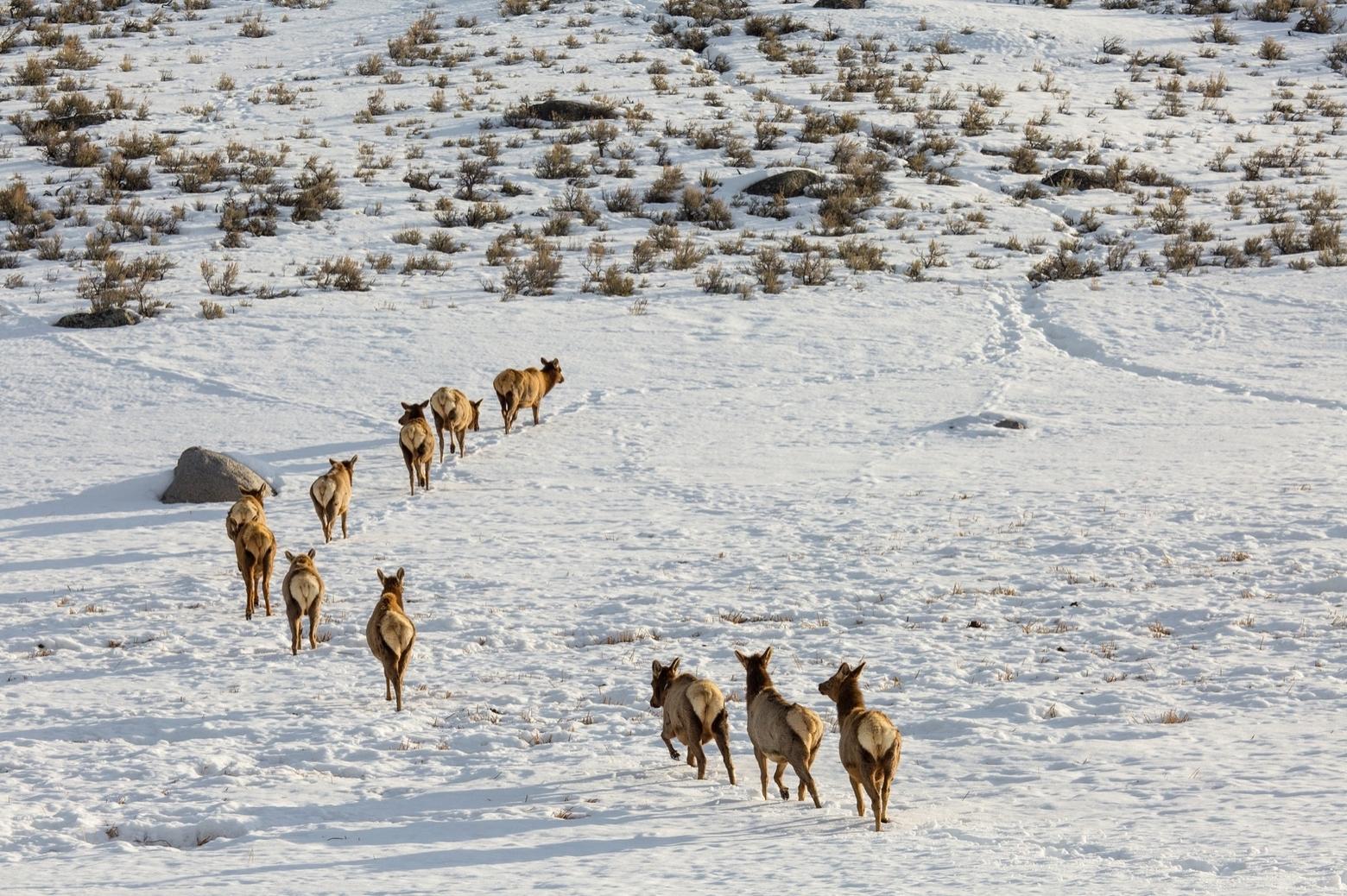Back to StoriesFewer Elk Counted This Year On Yellowstone's Famous Northern Range—But What Does It Mean?
April 5, 2019
Fewer Elk Counted This Year On Yellowstone's Famous Northern Range—But What Does It Mean?Annual wapiti survey: apart from wolves and other wildlife meat eaters, a formidable predator is winter
Fewer elk were counted last month in the annual aerial census of wapiti inhabiting Yellowstone National Park’s iconic Northern Range, home to one of the most famous populations of elk on the continent.
While the tabulation made by field scientists from Yellowstone, the state of Montana, US Forest Service and US Geological Survey is certain to spur lively speculation once again about the impact of wolves on the herd, this year’s tally is accompanied by a harsh reality on the ground, its effects yet to be fully ascertained.
Scientists say it’s shaping up to be a mega spring of winter-killed wildlife throughout the Greater Yellowstone Ecosystem.
For the second winter in a row, wild ungulates—elk, mule deer, bison and pronghorn in the northern tier of Yellowstone and spilling into Montana—have encountered brutally harsh weather conditions, with heavy snowfall and bitter cold in February likely to yield a significant death toll and possibly reduced reproduction.
“It’s been a really tough winter. The elk that survived are generally in poor physical condition. I’ve never seen seen anything like it in the years I’ve been doing this work,” Karen Loveless, a wildlife biologist with the Montana Department of Fish Wildlife and Parks tells Mountain Journal after the aerial survey results were released. “These impacts could ripple for a while.”
The 2019 count was conducted between March 17 and March 19. Some 5,800 elk were observed across the vast Northern Range survey area—1,361 individuals or 23.5 percent of the total, were spotted inside Yellowstone Park and 4,149, or 71.5 percent, viewed outside of the park in lower elevation areas of Montana.
(Note: Mountain Journal does not know why those figures do not add up to 100 percent).
The 2019 figure is 23 percent lower than both the 7,579 elk observed a year ago and the 7,510 elk tallied in 2016, the three government agencies stated in a release of the data. Still, Loveless noted, the estimate is higher than the 10-year average of 5,399 elk. What the count doesn’t measure is how many weakened animals will perish in the weeks ahead. A better sense of that will became evident with carcass counts.
Biologists note that a single winter, by itself, does not indicate much, be it with an elk population or the deepening impacts of climate change. For example, 2019’s big snow year does not negate the well-documented trend of warmer winters, earlier melt out, hotter, drier summers and an earlier fire season. Lest we forget, epic fires in years’ past around Glacier National Park in northern Montana were preceded by epic winter snows.
What’s important is looking at trend-lines for wapiti and based upon observations of the last decade, elk numbers have been slowly growing following a decade in which the Northern Range elk herd fell from around 20,000 in the late 1980s and early 1990s to one-fourth the number a decade later in the wake of wolves being reintroduced in the winter of 1994.
The long-term average of observed elk numbers since surveys began in 1976 is 10,634 elk, with a peak high count of 19,045 elk in 1994 and a low count of 3,915 elk observed in 2013.
“My sense is that the population has been growing, at a slow pace, not skyrocketing,” Loveless said. “The reason is we’ve had good calf recruitment for the last few years prior to this and last winter.” Earlier the herd benefitted from mild conditions more conducive to keeping elk mothers more robust, having successful pregnancies and better calf survival. Cow-calf ratios are considered a crucial metric in plotting population growth or decline.
Of the 5,800 elk counted, scientists classified 5,510 elk by age and sex, resulting in ratios of 15.2 calves, 5.2 yearling bulls and 12.6 brow-tined bulls per 100 cows. Calf and yearling bull ratios were lower than recent surveys and long-term averages. Brow-tined bulls, a.k.a. bulls with antlers, are the most coveted by outfitters, guides and their clients.
Brow-tined bull ratios were higher than in recent surveys, but below long-term average, Loveless said. Scientists observed 16 percent fewer cows, 46 percent fewer calves and 42 percent fewer yearling bulls as compared to the 2016 classification survey. Brow-tined bull numbers increased by 21.3 percent from 432 observed in 2016 to 524 observed in 2019.
This is the second consecutive year with calf ratios below the threshold of 20 calves per 100 cows considered necessary to maintain a stable population. It is likely that additional winter mortalities will occur into spring, further reducing overall numbers and recruitment,”the scientists wrote. “Below-average yearling bull and calf recruitment is likely to result in lower numbers of brow-tined bulls being recruited into the population over the next two years.”
A lot of different variables are in play. Most water resource stations measuring snow depth report above-average levels in the mountains but more important is when and how much snow fell.
The blitz of snow that came to Greater Yellowstone in midwinter arrived after a relatively easy January and indicative of this is the fact that the National Elk Refuge in Jackson Hole didn’t commence its controversial artificial feeding of elk until mid-February. Officials are expecting to find a high winter-kill count in Wyoming after the snow melts.
The Yellowstone-Montana aerial elk count is far from exact. Only the animals seen are tallied, and the those conducting the survey acknowledge they’re probably only counting three-fifth of the elk numbers actually out there. Beyond that, the method used in 2019 was different from the one in 2018 and that’s due in part to the federal government shutdown.
Normally, three Piper Cub airplanes are flown in a single day; instead, this year, a helicopter was used over three days. Also unusual is that Paradise Valley, because of its winter winds, typically does not become blanketed in deep snow yet it happened as a result of mid-winter storms. Thus, it could result in a higher number of winter-killed elk there and in Yellowstone.
“Every winter is a survival test for ungulates, some harder than others,” says Yellowstone’s chief wolf scientist Doug Smith. “They go into winter with fat reserves and there’s a hope they won’t have to use them all. But in a winter like this they burned through those reserves and needed to find forage but it was covered up by deep snow, denying them access. It’s created a double whammy and those two things leave them weakened and more vulnerable to predators.”
Here, an important distinction must be made. Harsh, deep-snow winters kill stressed wildlife outright and they leave animals weakened so they are easier for predators to take.
Many variables affect elk numbers. Winter survival; the abundance or lack of abundance of nutritious grasslands at crucial times in spring, summer and autumn influences successful cow elk pregnancy; predation by wolves, grizzlies and mountain lions; development pushing elk out of optimal habitat; and what often gets less scrutiny, the impacts of human hunting.
For years, the area called Deckard Flats and Eagle Creek just beyond Yellowstone’s northern boundary outside of Gardiner, Montana has cultivated a notorious reputation for being a firing line where hunters gather and wait for elk to migrate out of the national park across open treeless terrain.
Some autumns, when early snows drove elk out of the park early and hunters stood ready, a huge percentage of bulls have been taken, prompting Montana wildlife officials to limit the season in a five-year attempt to rebuild the number of bulls. Of course, critics of that strategy blame wolves, not hunters, for fewer bulls.
The truth is that the river valleys north of Yellowstone Park do not have dense wolf populations. Liberal state hunting regulations, which allow individual human hunters and trappers to take up to five lobos each, have resulted in wolf numbers being suppressed and not really having a significant impact on elk numbers, Loveless said.
Directly adjacent to Yellowstone, the state has imposed a hunting quota of two wolves to insure that beloved packs inside the park are not annihilated when they cross the invisible park boundary. It hasn’t stopped popular radio-collared wolves from being killed. Some biologists believe that wolves and a healthy guild of predators and scavengers can help slow the spread of dreaded Chronic Wasting Disease in elk and mule deer.
Studies show that each adult wolf in Yellowstone consumes between 16 and 22 elk annually. That translates to about four elk per month in early winter, 2.2 elk per month in late winter and in summer the number drops. Overall, it equates to an average of about 1.8 elk per wolf per month, Smith says. Recent research suggests that the number of elk being taken by cougars is higher than people might expect and studies show that grizzlies are eating elk calves.
The current status of the Northern Yellowstone elk herd needs to be considered within the larger historic context of the last 30 years. The dramatic reduction in wapiti numbers since the arrival of wolves elicited immediate outrage from hunters, guides and outfitters who claimed lobos wolves have brought disastrous ecological consequences.
This is strongly refuted by reality. Today, research confirms the presence of a stronger diversity of species than existed when Yellowstone’s Northern Range was dominated by elk and coyotes, both of which prospered in the absence of wolves.
Notably, and ironically, Yellowstone during the 1980s and 1990s had been accused of gross mismanagement in books such as Playing God In Yellowstone by Livingston author Alston Chase, the award-winning Yellowstone’s Destabilized Ecosystem: Elk Effects, Science and Policy Conflict by Utah State science professor Frederic H. Wagner by researchers Charles Kay and observations made by former Yellowstone field biologist Richard Keigley.
All four were outspoken in their criticism of Yellowstone’s natural regulation policy. They claimed it resulted in way too many elk inhabiting the park’s Northern Range, setting off a wide array of negative impacts, including decimation of aspen and willow, and soil erosion. They said that elk numbers needed to be dramatically reduced to bring them in line with the ecological carrying capacity of their environment.
Many outfitters and guides, embracing the attacks waged by Chase, Kay and Wagner on Yellowstone, agreed that elk numbers needed to drop and they were ecstatic when the state of Montana complied by setting aggressive elk hunting quotas, long seasons and even a controversial late season hunt that allowed pregnant cow elk to be killed.
Many outfitters and guides, embracing the attacks waged by Chase, Kay and Wagner on Yellowstone, agreed that elk numbers needed to drop and they were ecstatic when the state of Montana complied by setting aggressive elk hunting quotas, long seasons and even a controversial late season hunt that allowed pregnant cow elk to be killed. Those years, however, were anomalies; there will likely never be elk numbers like those again on the Northern Range nor the profits that came with the unnaturally high population..
“Remember we had 20,000 elk and it took a long time for them to get to that point without predation and much competition from other ungulates,” Loveless says. “When we had 20,000 elk there were far fewer bison. Today there’s a lot more bison on the Northern Range.”
She isn't suggesting predators aren't having an impact and she is sympathetic to the fact that the livelihoods of outfitters and guides in the Upper Yellowstone and Paradise valleys depend on being able to sell hunts.
Today, elk experts besides Loveless say it was a combination of Montana's liberal hunting regulations decades ago that likely had a huge and rippling impact on highly-reproductive female elk, along with predators, harsh winters, and several years of drought conditions reducing natural forage, that drove elk numbers down. Some don't like the idea of wolves taking any elk at all.
In 2017, an above-average hunter's take of 305 bulls near Gardiner occurred when early snowstorm pushed elk out of Yellowstone compared to a year before when a milder hunting season resulted in more elk remaining in the park.
Chase, Kay and Wagner have gone almost silent in their criticism of Yellowstone’s elk management, though some gadflies are now pointing a finger at the park arguing there are “too many bison”t hough advocates say that’s because, unlike elk, bison are not allowed to move out of heavy snows in winter and remain bottled inside Yellowstone because of an unjustified hysteria created over them being carriers of brucellosis.
Only in the last decade have numbers of predators and prey returned to ebb and flow in some semblance of dynamic equilibrium. That’s reflected in wolf numbers, too. In the years following wolf reintroduction, lobo numbers on Yellowstone’s Northern Range rose. In 2003, there were around 174 wolves and 13 to 14 packs in Yellowstone. Today, there are around 11 packs, many comprised of fewer animals, and slightly less than 100 wolves in the park.
In recent years, the number of wolves in Yellowstone has fluctuated between 83 and 110, a direct response to available food. Currently 85 live in the park, 35 of which are on the Northern Range.
PLEASE SUPPORT US: Mountain Journal is committed to giving you stories and perspective you won't get anywhere else—stories that take time to produce. We rely upon the generosity of readers and we can't survive without you. Please click here to support a fearless publication devoted to watchdogging the most iconic wildlife ecosystem in America. Thank you.








